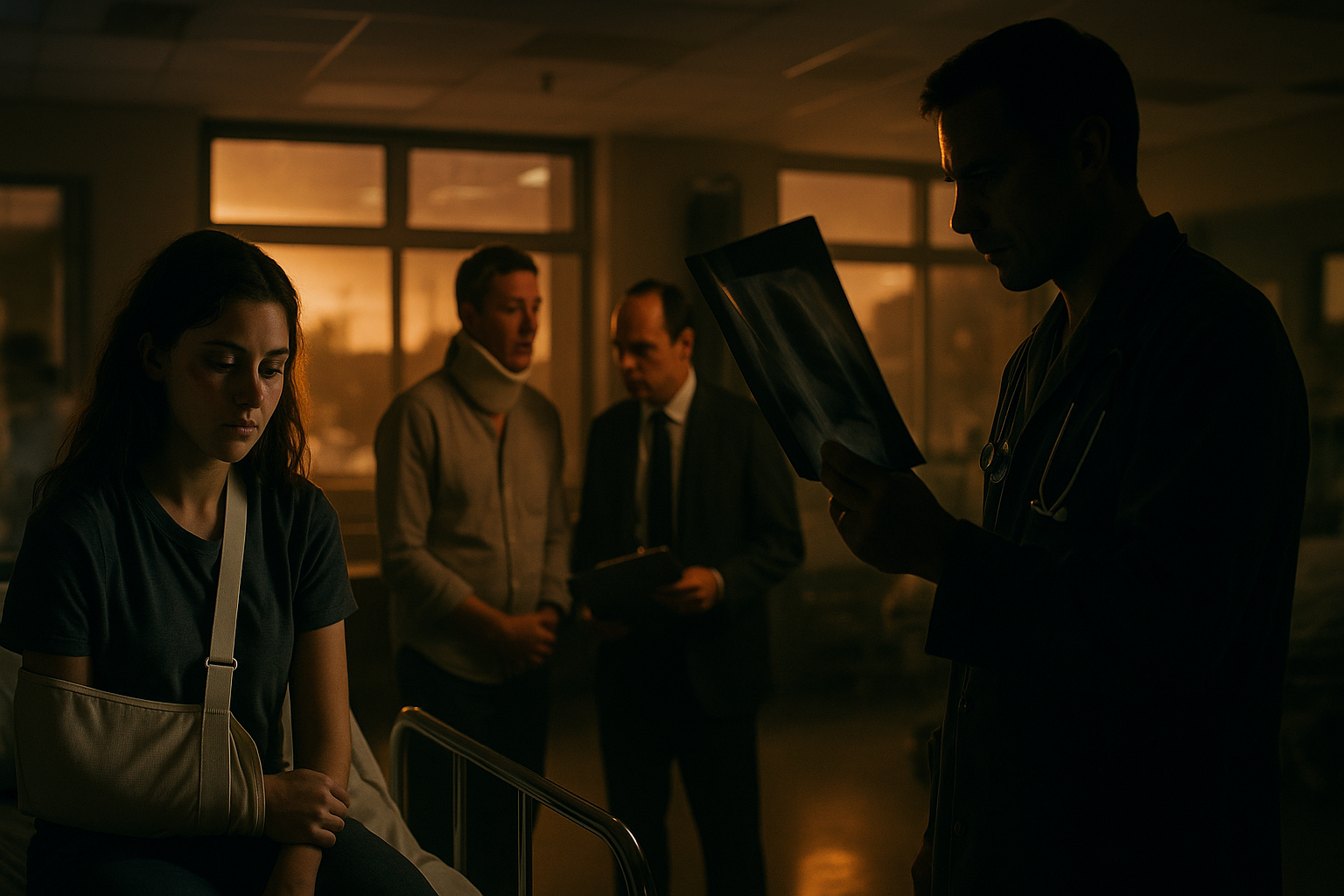Table of Contents

Estimated reading time: 16 minutes
Key Takeaways
- Recognizing common car accident injuries is crucial for health and legal claims.
- Severity and type of injury directly affect compensation and claim outcomes.
- Prompt medical evaluation and thorough documentation support successful claims.
- Different injuries require distinct legal approaches and evidence strategies.
- Consulting experienced attorneys improves chances of maximizing recovery.
Introduction: The Importance of Recognizing Common Car Accident Injuries
Common car accident injuries – a term used to describe the physical harms most frequently sustained by individuals in auto collisions – are among the most significant consequences of car crashes. These injuries range from mild muscle strains and bruises to life-altering trauma such as broken bones, brain injuries, and organ damage (Bellevue Trial Attorney, Sterling Medical Group). Understanding common car accident injuries is crucial not just for health, but also for the legal process that often follows a vehicle crash Learn more here.
Immediate recognition and medical treatment for common car accident injuries such as brain injury auto accident, broken bones car crash injury, and soft tissue damage car accident are vital for preventing complications. From a legal standpoint, clear documentation and accurate diagnosis are central to any successful or fair personal injury claim (Alexander Orthopaedics, Insurance.ca.gov).
The type and severity of your injuries determine your eligibility for compensation, the amount you may receive, and how long the claim process will take. This makes prompt identification and documentation of all car crash injuries a necessity for anyone seeking recovery—physically and financially (Werner Hoffman).
Keywords: common car accident injuries, brain injury auto accident, broken bones car crash injury, soft tissue damage car accident
Overview of Common Car Accident Injuries
Car accidents can cause a wide range of injuries. Understanding the types of common car accident injuries helps you recognize symptoms and appreciate how they affect your health and legal rights. Learn more here.
Main Types of Common Car Accident Injuries
- Whiplash: This is a neck injury caused by a rapid back-and-forth motion, often seen in rear-end collisions. Symptoms include neck pain, stiffness, and reduced range of motion.
- Brain injury auto accident: Car crashes often lead to traumatic brain injuries (TBI), including concussions. Symptoms may be immediate or delayed and include confusion, dizziness, headaches, nausea, memory issues, and even long-term cognitive problems.
- Broken bones car crash injury: Fractures are frequent, especially affecting the arms, legs, ribs, or hips. The force from a collision can break bones—even with seatbelt use or airbags.
- Soft tissue damage car accident: These injuries involve sprains, strains, muscle damage, and tendon or ligament injury—usually affecting the neck, back, shoulders, or limbs.
- Burns and Internal Injuries: Burns may result from fire, hot fluids, or chemicals during a crash. Internal injuries can harm organs like the liver, lungs, or spleen, sometimes leading to life-threatening conditions.
Severity and Symptom Onset:
- Some common car accident injuries cause immediate, severe pain. Others, such as soft tissue damage or concussions, may only become obvious hours or days after the accident. This delayed onset underscores the importance of seeing a doctor after any car accident (Alexander Orthopaedics).
Medical Assessment:
- Always seek prompt evaluation. Early documentation by medical professionals will support both your recovery and your future legal claim Learn more here.
Keywords: common car accident injuries, brain injury auto accident, broken bones car crash injury, soft tissue damage car accident
Research Sources:
https://www.bellevuetrialattorney.com/car-accident-injuries-statistics/
https://sterlingmedgroup.com/car-accident-injuries/
Soft Tissue Damage Car Accident: Recognizing and Proving Injuries
What is Soft Tissue Damage in Car Accidents?
Soft tissue damage refers to trauma affecting muscles, tendons, and ligaments. These are among the most frequent common car accident injuries because the rapid forces in a crash can stretch or tear the body’s soft tissues.
Types of Soft Tissue Damage:
- Sprains: Involve stretched or torn ligaments (e.g., ankle, knee, wrist sprains).
- Strains: Injuries to muscles or tendons, sometimes causing back or neck pain.
- Whiplash: A specific neck strain from rapid back-and-forth motion.
Even low-speed collisions can cause soft tissue damage car accident injuries. The impact may lead to swelling, bruising, sharp or dull pain, and restrict normal movement.
Diagnosis Challenges:
- Soft tissue injuries typically do not appear on X-rays or CT scans, making them harder to diagnose and, crucially, to prove in legal settings.
- Doctors rely on physical exams, patient-reported symptoms, and clinical notes.
Legal Aspects:
- Proving soft tissue damage car accident claims often requires:
- Thorough clinical notes and detailed medical records.
- Sometimes, testimony from medical experts to validate injury impact and prognosis.
- Clear evidence and documentation to counteract insurance adjuster challenges Learn more here.
- Without visible imaging evidence (like with broken bones), insurance adjusters and opposing attorneys may challenge these claims more aggressively.
Key Symptoms to Document:
- Persistent pain and tenderness.
- Swelling at the injury site.
- Reduced flexibility or range of motion.
Prompt, consistent medical documentation and follow-up are vital.
Keywords: soft tissue damage car accident, common car accident injuries
Research Sources:
https://www.bellevuetrialattorney.com/car-accident-injuries-statistics/
https://alexanderorthopaedics.com/blog/common-car-accident-injuries/
Broken Bones Car Crash Injury: Medical and Legal Impacts
Most Frequent Broken Bones in Car Accidents
When discussing common car accident injuries, fractures or broken bones stand out due to their immediate significance and clear proof on diagnostic scans.
Most Commonly Broken Bones:
- Legs (Femur, Tibia, Fibula): Often fractured, sometimes severely, in high-speed collisions or when legs are braced against the floor.
- Ribs: Frequently broken by the force of a seatbelt or airbag deployment.
- Hips, Arms, Wrists: Common injuries when occupants brace themselves prior to impact or when thrown against parts of the vehicle.
- Back, Skull, and Facial Bones: Result from high-impact or when a body part strikes hard surfaces within the vehicle.
How Do These Injuries Happen?
Direct collisions, ejection from the vehicle, or bracing upon impact can cause immense stress on the bones, leading to breaks.
Treatment and Recovery:
- Immobilization: Casts or splints are standard for non-displaced or simple fractures.
- Surgical Intervention: Required for complex, displaced, or compound fractures. Hardware (rods, pins, plates) may be necessary.
- Recovery Time: Varies from several weeks (for simple wrist fractures) to many months (for complex or weight-bearing bones such as hips or legs).
Legal Ramifications:
- Claims involving broken bones car crash injury are often more straightforward because X-rays, MRIs, or CT scans provide unambiguous evidence.
- Documentation increases claim value, as does the demonstrated impact on function or workability.
- Insurance companies tend to settle these claims with less resistance than soft tissue cases.
- These injuries can result in lasting disabilities, impairment ratings, and higher compensation for pain and suffering, medical expenses, and lost income.
Increase your understanding of how these injuries impact legal claims by reviewing this guide on injury assessment Learn more here.
Keywords: broken bones car crash injury, common car accident injuries
Research Sources:
https://sterlingmedgroup.com/car-accident-injuries/
https://www.bellevuetrialattorney.com/car-accident-injuries-statistics/
Brain Injury Auto Accident: Lasting Impact and Legal Complexity
When a brain injury auto accident occurs, the medical and legal consequences are usually severe. These are some of the most serious common car accident injuries and require special attention.
What Are Brain Injuries from Auto Accidents?
Types include:
- Concussions: Mild traumatic brain injuries (TBI). Symptoms may include headache, confusion, balance issues.
- Moderate to Severe TBI: Can involve bleeding, swelling, or physical damage to brain tissue, with symptoms ranging from memory loss and cognitive impairment to coma or death.
- Open or Penetrating Head Injuries: Occur when an object pierces the skull.
Typical Causes:
- A direct blow to the head during a collision.
- Rapid deceleration causing the brain to move inside the skull.
- Debris or fractured bone penetrating the cranium.
Symptoms to Watch For:
- Persistent headache.
- Dizziness and nausea.
- Confusion, amnesia.
- Changes in mood or personality.
- Difficulty with balance, speech, or coordination.
- Loss of consciousness or coma.
Immediate medical evaluation is crucial. The symptoms of a brain injury may not show up right away, but delayed treatment can result in lasting disability or even fatality.
Legal Challenges and Claim Value:
- Brain injury auto accident claims are complex:
- Symptoms may be subtle and subjective.
- Requires specialist evaluation (neurologist, neuropsychologist).
- Often involve high-value settlements or awards due to long-term impact on life, work, and independence.
- Future costs and loss of earnings factor heavily into settlement calculations.
- Extensive, timely medical records—plus objective findings from imaging—make these claims winnable. However, insurance companies may dispute the extent of the injury, so expert testimony is often needed.
Keywords: brain injury auto accident, common car accident injuries
Research Sources:
https://www.bellevuetrialattorney.com/car-accident-injuries-statistics/
https://alexanderorthopaedics.com/blog/common-car-accident-injuries/
Back Injury Car Accident Claim: Spinal Damage and Your Legal Rights
Car crashes are a leading cause of serious back injuries, many of which result in long-term pain or disability. A strong back injury car accident claim depends on comprehensive diagnosis and clear documentation.
Types of Back Injuries in Car Accidents
- Herniated Discs: The disc between spinal vertebrae bulges or ruptures; can compress nerves and cause radiating pain.
- Spinal Cord Injuries: Damage may lead to partial or total paralysis, sensory loss, or permanent disability.
- Strains and Fractures: Tearing of muscles or ligaments in the back, or breaking bones in the spinal column.
Diagnosis and Medical Evaluation
- Imaging Tests: MRI, CT scans, and X-rays are essential for revealing the extent and type of injury.
- Objective Findings: These technologies provide proof of physical damage, which is fundamental for both medical management and legal proceedings.
- Impairment Ratings: Doctors may assign an impairment rating to help quantify disability.
Complications to Note:
- Chronic pain: Lingering or intermittent discomfort that impacts daily activities.
- Reduced mobility: Difficulty standing, walking, or returning to normal work and recreation.
Legal Ramifications
- The back injury car accident claim process hinges on:
- Severity and permanence of the injury.
- Clear, timely medical documentation.
- Projected long-term consequences and need for ongoing care.
- Objective imaging results typically make back injury claims more persuasive to insurance companies and courts.
Keywords: back injury car accident claim, common car accident injuries
Research Sources:
https://sterlingmedgroup.com/car-accident-injuries/
https://www.bellevuetrialattorney.com/car-accident-injuries-statistics/
https://alexanderorthopaedics.com/blog/common-car-accident-injuries/
Impact of Common Car Accident Injuries on Legal Claims
The nature and severity of common car accident injuries directly determine the value, ease, and outcome of your injury claim Learn more here.
How Each Injury Type Affects Your Legal Claim
- Severe injuries (brain injuries, spinal cord trauma): Permanent or disabling common car accident injuries usually receive higher compensation due to their lasting effects on health, employment, and quality of life.
- Requires expert testimony and extensive documentation.
- Settlement values often reflect anticipated medical and care needs.
- Soft tissue damage car accident: These claims are harder to win as injuries are less visible in imaging.
- To support these cases, patients need precise clinical records, evidence of ongoing symptoms, and often expert witnesses.
- Settlement offers may be lower unless claimants can demonstrate ongoing impairment.
- Broken bones car crash injury: Easily confirmed by X-ray or CT/MRI imaging, these claims usually proceed with less dispute.
- High likelihood of reimbursement for medical costs, rehabilitation, lost earnings, and pain and suffering.
- Back injury car accident claim: These often involve complex medical records and must clearly detail the connection between the accident and disability.
- Chronic pain and reduced function may boost damages, especially if supported by imaging and doctor’s reports.
- Brain injury auto accident: Require an extra layer of proof due to the challenge of demonstrating cognitive or behavioral changes.
- Consistent, detailed records from specialists are mandatory.
- These claims are high-value and often litigated more aggressively.
Evidence to Support a Legal Claim
Your attorney will build your claim using a variety of evidence:
- Medical records and diagnostic imaging (X-ray, MRI, CT scan).
- Photographs of your injuries and the scene.
- Witness statements and accident reports.
- Expert opinions from medical or accident reconstruction professionals.
- Documentation of missed time at work, impacts on everyday life, and future medical needs.
Why Immediate and Comprehensive Medical Documentation Matters:
- Gaps in treatment or inconsistent reports can weaken your legal position.
- Early records are critical for tying injuries directly to the accident and avoiding disputes from insurance adjusters.
Working with Experienced Attorneys:
- Navigating the complexities of common car accident injuries claims requires expertise in both medical and legal fields.
- Attorneys help collect necessary evidence, work with medical experts, and negotiate or litigate for the best compensation (Werner Hoffman, Insurance.ca.gov).
Keywords: common car accident injuries, back injury car accident claim, soft tissue damage car accident, brain injury auto accident, broken bones car crash injury
Research Sources:
https://sterlingmedgroup.com/car-accident-injuries/
https://alexanderorthopaedics.com/blog/common-car-accident-injuries/
https://www.bellevuetrialattorney.com/car-accident-injuries-statistics/
https://wernerhoffman.com/blog/statistical-insight-into-types-of-car-accidents/
https://www.insurance.ca.gov/01-consumers/105-type/95-guides/01-auto/hadaccident.cfm
Conclusion: Maximizing Your Recovery and Your Rights
Recognizing common car accident injuries and understanding their impact is essential for both your health and the outcome of any personal injury or insurance claim. Whether you suffer from a back injury car accident claim, brain injury auto accident, soft tissue damage car accident, or broken bones car crash injury, each injury type brings unique characteristics, medical needs, and legal implications.
What you do after an accident can make or break your chances of maximizing compensation:
- Seek immediate medical attention–even for minor symptoms, as issues like soft tissue injuries or brain trauma may present later.
- Consult with an experienced attorney to navigate the complex claims process and ensure proper documentation and strategy Learn more here.
Knowledge is power. Being informed about the different types of car accident injuries and their corresponding legal hurdles or opportunities optimizes health outcomes and increases the likelihood of obtaining the compensation you deserve.
Take the Next Step:
If you or a loved one has suffered any of these injuries in a car accident, don’t leave your recovery or compensation to chance. See if your case qualifies with a free, instant case evaluation from Visionary Law Group. Find out in just 30 seconds:
https://eval.visionarylawgroup.com/auto-accident
Keywords in this article: common car accident injuries, back injury car accident claim, brain injury auto accident, soft tissue damage car accident, broken bones car crash injury.
Research Sources:
https://www.bellevuetrialattorney.com/car-accident-injuries-statistics/
https://sterlingmedgroup.com/car-accident-injuries/
https://alexanderorthopaedics.com/blog/common-car-accident-injuries/
https://wernerhoffman.com/blog/statistical-insight-into-types-of-car-accidents/
https://www.insurance.ca.gov/01-consumers/105-type/95-guides/01-auto/hadaccident.cfm
FAQ
What are the most common types of car accident injuries?
The most common types include soft tissue damage (such as whiplash), brain injuries (including concussions), broken bones, burns, internal injuries, and back injuries like herniated discs or spinal cord damage.
Why is immediate medical evaluation important after a car accident?
Immediate evaluation helps identify injuries early, preventing complications and ensuring thorough documentation to support legal claims for compensation.
How do soft tissue injuries affect legal claims differently from broken bones?
Soft tissue injuries often lack visible evidence on imaging, making them harder to prove and more likely to be challenged by insurance companies, whereas broken bones usually have clear diagnostic proof.
What kind of evidence helps support a car accident injury claim?
Key evidence includes medical records, diagnostic images, photographs, witness statements, expert opinions, and documentation of lost wages and daily life impacts.
How can an attorney assist with a car accident injury claim?
An attorney helps navigate the legal process, gather and present evidence, work with medical experts, and negotiate or litigate to obtain the best possible compensation.



